[fsn_row][fsn_column width=”12″][fsn_text]
Cyber attacks are a constant risk, and like other threats such as floods or theft, the insurance industry stands ready to help minimize the risk: behold cyber insurance. While adoption continues to grow, a study by Spiceworks shows that 38 percent of organizations across North America and Europe already have an active policy.
It’s a relatively new risk mitigation strategy. Nearly half of the organizations with policies have purchased the insurance within the last two years. 32 percent have three to four-year-old policies and only 24 percent have been covered more than five years. For those without a policy, 11 percent indicated they intend to purchase a cyber insurance policy within the next two years.
What’s all this cyber insurance worth? About half of the responding companies with coverage are insured from one to five million dollars, nearly 20 percent are covered from six to 10 million. 16 percent of companies were covered for more than 10 million dollars.
Are these policies being put to the test? Only 7 percent with policies reported ever filing a claim on their cyber insurance policies.
While most of these policies are focused around the penalties from regulations such as GDPR that imposes significant fines in response to breaches of personal information, cyber risk involves much more.
When it comes to operational risks such as downtime and response delays, Uplogix provides a different kind of cyber insurance. Uplogix gives network admins the tools and secure connectivity to react to a cyber attack event effectively and swiftly — onsite or across a globally-distributed network.
Based on a closed appliance, Uplogix can push out golden configs that lock down network infrastructure when a threat is detected. Then as the threat is better understood, Uplogix can bring up sections of the network safely and from the NOC.
Remember the quote, “Fun is like life insurance. The older you get, the more it costs.” When it comes to cyber insurance, will data protection really be enough, or do you need to think about the functional insurance of knowing you’ll be able to respond to a cyber event?
[/fsn_text][/fsn_column][/fsn_row]





